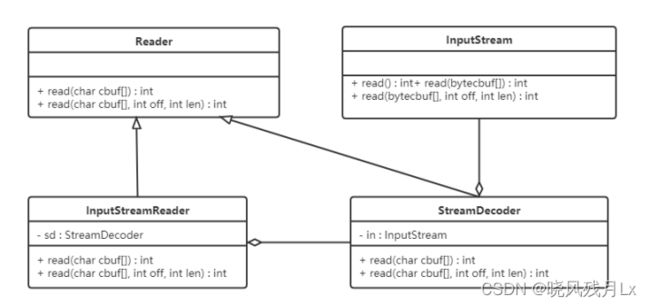Gof23设计模式之适配器模式
1.定义
将一个类的接口转换成客户希望的另外一个接口,使得原本由于接口不兼容而不能一起工作的那些类能一起工作。
适配器模式分为类适配器模式和对象适配器模式,前者类之间的耦合度比后者高,且要求程序员了解现有组件库中的相关组件的内部结构,所以应用相对较少些。
2.结构
适配器(Adapter)包含以下主要角色:
- 目标(Target)接口:当前系统业务所期待的接口。它可以是抽象类或接口
- 适配器(Adaptee)类:它是被访问和适配的现存组件库中的组件接口
- 适配器(Adapter)类:它是一个转换器,通过继承或引用适配者的对象,把适配者接口转换成目标接口,让客户按目标接口的格式访问适配者
3.类适配器模式
实现方式:定义一个适配器类来实现当前系统的业务接口,同时又继承现有组件库中已经存在的组件。
/**
* @author 晓风残月Lx
* @date 2023/7/2 17:04
* 目标接口
*/
public interface SDCard {
// 从SD卡中读取数据
String readSD();
// 往SD卡中写数据
void writeSD(String msg);
}
/**
* @author 晓风残月Lx
* @date 2023/7/2 16:24
* 适配者类的接口
*/
public interface TFCard {
// 从TF卡中读取数据
String readTF();
// 往TF卡中写数据
void writeTF(String msg);
}
/**
* @author 晓风残月Lx
* @date 2023/7/2 17:05
* 具体的SD卡
*/
public class SDCardImpl implements SDCard {
@Override
public String readSD() {
String msg = "SDCard read msg : hello world sd";
return msg;
}
@Override
public void writeSD(String msg) {
System.out.println("SDCard write :" + msg);
}
}
/**
* @author 晓风残月Lx
* @date 2023/7/2 16:26
* 适配者类
*/
public class TFCardImpl implements TFCard {
@Override
public String readTF() {
String msg = "TFCard read msg: hello world tf";
return msg;
}
@Override
public void writeTF(String msg) {
System.out.println("TFCard write msg :" + msg);
}
}
/**
* @author 晓风残月Lx
* @date 2023/7/2 17:08
* 计算机类
*/
public class Computer {
// 从SD卡中读取数据
public String readSD(SDCard sdCard) {
if (sdCard == null) {
throw new NullPointerException("sd card is not null");
}
return sdCard.readSD();
}
}
/**
* @author 晓风残月Lx
* @date 2023/7/2 17:15
* 适配器类
*/
public class SDAdapterTF extends TFCardImpl implements SDCard {
@Override
public String readSD() {
System.out.println("adapter read tf card");
return readTF();
}
@Override
public void writeSD(String msg) {
System.out.println("adapter write tf card");
writeTF(msg);
}
}
/**
* @author 晓风残月Lx
* @date 2023/7/2 17:10
*/
public class Client {
public static void main(String[] args) {
// 创建计算机对象
Computer computer = new Computer();
// 读取SD卡中的数据
String msg = computer.readSD(new SDCardImpl());
System.out.println(msg);
System.out.println("======================");
// 使用该电脑读取TD卡中的数据
// 定义适配器类
String msg1 = computer.readSD(new SDAdapterTF());
System.out.println(msg1);
}
}
4.对象适配器模式
实现方式:对象适配器模式可采用将现有组件库中已经实现的组件引入适配器类中,该类同时实现当前系统的业务接口。
与类适配器模式相比只需要修改适配器类(SDAdapterTF)
/**
* @author 晓风残月Lx
* @date 2023/7/2 17:15
* 适配器类
*/
public class SDAdapterTF implements SDCard {
// 声明适配者类
private TFCard tfCard;
public SDAdapterTF(TFCard tfCard) {
this.tfCard = tfCard;
}
@Override
public String readSD() {
System.out.println("adapter read tf card");
return tfCard.readTF();
}
@Override
public void writeSD(String msg) {
System.out.println("adapter write tf card");
tfCard.writeTF(msg);
}
}
/**
* @author 晓风残月Lx
* @date 2023/7/2 17:10
*/
public class Client {
public static void main(String[] args) {
// 创建计算机对象
Computer computer = new Computer();
// 读取SD卡中的数据
String msg = computer.readSD(new SDCardImpl());
System.out.println(msg);
System.out.println("======================");
// 使用该电脑读取TF卡中的数据
String msg1 = computer.readSD(new SDAdapterTF(new TFCardImpl()));
System.out.println(msg1);
}
}
注意:还有一个适配器模式是接口适配器模式。当不希望实现一个接口中所有的方法时,可以创建一个抽象类Adapter ,实现所有方法。而此时我们只需要继承该抽象类即可。
5.应用场景
- 以前开发的系统存在满足新系统功能需求的类,但其接口同新系统的接口不一致
- 使用第三方提供的组件,但组件接口定义和自己要求的接口定义不同
6.JDK源码分析
Reader(字符流)、InputStream(字节流)的适配使用的是InputStreamReader。
InputStreamReader继承自java.io包中的Reader,对他中的抽象的未实现的方法给出实现。
public int read() throws IOException {
return sd.read();
}
public int read(char cbuf[], int offset, int length) throws IOException {
return sd.read(cbuf, offset, length);
}
- InputStreamReader是对同样实现了Reader的StreamDecoder的封装
- StreamDecoder不是Java SE API中的内容,是对Sun JDK给出的自身实现。但我们知道他们对构造方法中的字节流类(InputStream)进行封装,并通过该类进行了字节流和字符流之间的解
码转换。
结论:
从表层来看,InputStreamReader做了InputStream字节流类到Reader字符流之间的转换。而从如上Sun JDK中的实现类关系结构中可以看出,是StreamDecoder的设计实现在实际上采用了适配器
模式。
